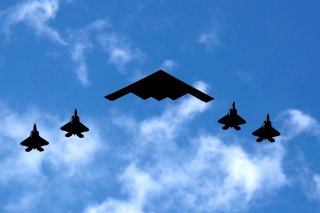How Hellish a U.S.-Iran War Could Get
Iran’s real defense against U.S. strikes isn’t some radar, missile system or fighter. It’s the country’s capacity for carrying out “asymmetric” operations.
Here's What Your Need To Remember: Iran isn’t defenseless against U.S. air raids, as its shoot-down of a Navy drone proved. The Iranian armed forces and the Iranian Revolutionary Guard Corps militia operate Russian-made S-200 and S-300 air-defense systems as well as hundreds of fighters including dozens of modernized F-14s
U.S. president Donald Trump on June 26, 2019 said he could order U.S. forces to strike Iran without involving large numbers of American ground troops.
“It wouldn’t last very long, I can tell you that,” Trump said in an interview on Fox Business.
“I’m not talking boots on the ground,” Trump added. “I’m not talking, we’re going to send a million soldiers. I’m just saying if something would happen, it wouldn’t last very long.”
Trump’s comments hint at a possible U.S. plan for retaliating against Iran for the Islamic Republic’s June 19, 2019 downing of a U.S. Navy surveillance drone over the Strait of Hormuz, the strategic chokepoint connecting the Persian Gulf to the open ocean.
U.S. warships could fire cruise missiles while bombers launched their own missiles and stealth warplanes penetrated Iranian air defenses. U.S. presidents several times in recent years have opted to strike from the air in this manner rather than risk a ground war.
The major forces already are in the region or available on short notice. The U.S. Air Force in April 2019 deployed at least six F-35A stealth fighters to Al Dhafra in the United Arab Emirates. And in May 2019 the flying branch sent four B-52 bombers to Al Udeid air base in Qatar.
The F-35s have flown combat missions over Iraq. The B-52s meanwhile have conducted show-of-force flights near Iran. If Trump ordered U.S. forces to strike Iran, the B-52s could lob cruise missiles at Iranian targets from hundreds of miles away while the F-35s flew closer to drop GPS- and laser-guided bombs.
B-2 stealth bombers currently at their home base in Missouri could fly across the Atlantic Ocean to join the F-35s in close air strikes. In 2011 then-U.S. president Barack Obama ordered three B-2s to fly thousands of miles from Missouri to Libya in order to strike Libyan air defenses during the opening hours of the NATO air campaign over the North African country.
The B-2s required multiple mid-air refuelings that themselves demanded careful coordination. Air Force tanker planners surely have begun studying aerial-refueling plans in the event the White House requires B-2s to hit Iran.
The aircraft carrier USS Abraham Lincoln as of June 26, 2019 was in the Persian Gulf region with one cruiser and four destroyers as escorts. While Lincoln’s 40 F/A-18E/F fighters could contribute to strikes on Iran, their lack of stealth could expose them to Iranian defenses.
The escorts in Lincoln’s battle group all can carry Tomahawk cruise missiles. Trump twice in his presidency has ordered Navy warships to conduct limited missiles strikes, both times targeting Syria’s chemical-weapons infrastructure.
Iran isn’t defenseless against U.S. air raids, as its shoot-down of a Navy drone proved. The Iranian armed forces and the Iranian Revolutionary Guard Corps militia operate Russian-made S-200 and S-300 air-defense systems as well as hundreds of fighters including dozens of modernized F-14s that Iran acquired from the United States in the 1970s.
A special, long-range sensor helps tie together Iran’s air defenses. The country in 2014 revealed Ghadir, its first operational over-the-horizon sensor. OTH radars can detect stealthy and small targets at very long range, regardless of the target’s altitude.
These radars take advantage of a unique natural phenomenon. Instead of emitting radio waves directly into the target space, OTH radars blast very long wave pulses into the ionosphere.
Waves of certain frequencies bounce back down to the target area, enabling the radar to look at objects from above and identify them even behind ground terrain such as hills and mountains.
In addition to detecting stealth warplanes, OTH radars also can pick out ballistic missiles and even satellites in low orbit. Their long-range shields them from small-scale attacks by anti-radiation missiles and jammers.
On the downside, OTH radars are bulky, immobile and imprecise. The distance error in detecting a typical target can be as high as a kilometer. In short, Iran’s most powerful radar can detect U.S. forces, potentially including stealth warplanes, but it can’t target them.
Iran’s real defense against U.S. strikes isn’t some radar, missile system or fighter. It’s the country’s capacity for carrying out “asymmetric” operations such as terror attacks and sabotage.
If Trump orders air and missile strikes, he might just provoke further Iranian provocations and intensify the retaliatory cycle.
David Axe serves as Defense Editor of the National Interest. He is the author of the graphic novels War Fix, War Is Boring and Machete Squad. This first appeared last year.
Image: Reuters

